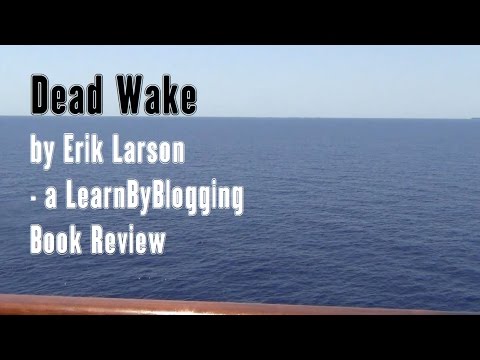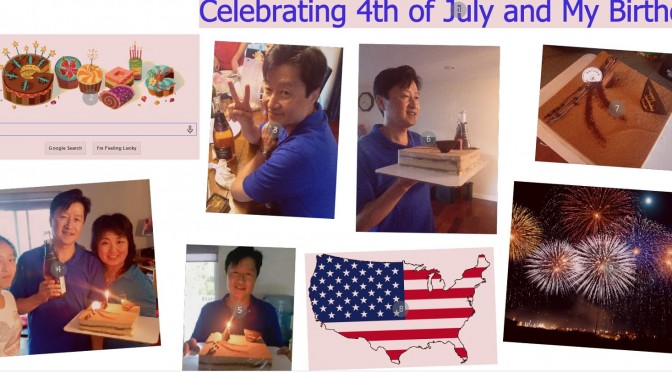This was one of the Greek Islands I visited during my vacation. Rhodes has a Lindos acropolis, Palace of the Grand Master of the Knights, and the Colossus (one of the seven wonders of the world). Hope you enjoy it.
Navplion, Greece Excursions – My Travel
Above is the first of the video series highlighting my recent travel to Europe. I had a lot of fun. Hope you enjoy it too!
Book Review: “Dead Wake” by Erik Larson
This book is all about the fastest cruise ship Lusitania between New York City and Britain’s Liverpool City back in the early 20th century in the middle of World War I. Titanic sunk a few years earlier and as a result more safety features like enough Life-saver jackets and Boats were put in place. It’s the pride of the Britain to be able travel as fast speed. At that time, the German submarines or U-boats started to terrorize the “allies” with their strategy of torpedoing most of the British boats: military OR civilian.
The stories were developed along three major tracks: the key people (Captain Turner and other memorable passengers) of the ship, the captain of the U-20 u-boat and around the development of U-boats, and Room 40, the British’s secret agency in tracking and deciphering of the German U-boat communications, and then US President Woodraw Wilson, his quest for his new love after the death of the First Lady.
Of course, at the end Lusitania was sunk by U-20 within the some small window of opportunity – call it bad luck or fate. This led to US’s joining the “Allies” in battling German and brought the war to the end.
What struck me are the following:
– Why German military was so careless in getting on the “bad” side of US in the conflict. The behavior seems to anger the rest of the world. I simply can’t figure out the motivation or what the conflicts between Britain and German were all about to have such a deep hatred toward one another in both World Wars.
– Is it really a conspiracy by Britain to make Lusitania the fall guy to get US on their side? There is some truth to it. I wouldn’t rule it out.
– No machines or ships are invincible. There is always some weakness of the design that could doom the entire ship without just a small injury, in this case, just one torpedo with 60% of making it out of the U-boat and smaller % of hitting the target, much less hitting the right spot on the boat.
– Reading this book during cruise trip makes the cruise trip a bit edgy. Maybe not a good idea. But I was pleasantly surprised the amenity in Lusitania was not much different from today’s cruise ship after 100 years, except for the better ship engine and cheaper tickets. Of course, today’s cruise is much safer than those days.
– One thing I learned that one should never take any emergency situation for granted. Always take every emergency situation seriously and follow all the necessary procedure and precaution. This is why we have emergency drill on the first day of the cruise.
– Woodrow Wilson’s prudence in participating in World War I was simply very different than what US would do nowadays. Perhaps, being neutral for so long may have prolonged the war and suffering longer than necessary.
– Woodrow Wilson was unusually lonely on the top without his wife. His pursuit of his new love seemed to bring out the human and vulnerable side of him, which is understandable.
– Winston Church had an active role in this book too. I didn’t know he was involved in both World War. Maybe that’s what makes him so tough.
This is a very good non-fiction book that reads like a novel. Characters were well developed and well researched which is difficult after nearly a century. If you’re interested in the World War I conflict and sea battles between Britain and Germany and US’s involvement, you will like this book and how the author position Lusitania incident to be a critical turning point. It kept me awake one night during my cruise trip.
Book Review: “Just Mercy: A Story of Justice and Redemption” by Bryan Stevenson
Mr. Stevenson should wear a cape or win the Nobel Peace Prize (My prediction). He’s like a modern Atticus Finch as in the novel “To Kill a Mocking Bird.” He saved many people from the death rows unjustly convicted because of the sloppy police work, being young and ignorant, mentally retarded (like Horace Dunkins), but mostly being poor. “The opposite of poverty is not wealth but justice,” as he’s often quoted. He wants to do more than Atticus Finch accomplished, where the jailed black man in the novel did not have a good ending.
My key takeaways are:
– The Walter McMillian case is an epitome of the racial injustice in this country especially in the south like the state of Alabama. It can be attributed to the prevailing racial bigotry against blacks especially ones that are relatively successful, uneasiness about interracial relationship (he had an extramarital affair with a white woman), and the legal maneuver of the over zealous prosecutors without concerns for the truths, and inertia of the legal system to not “rock the boat” or boosting the judges’ chance of being elected by acting tough and winning the votes. Of course, the biggest contributor to injustice is their poverty – not having enough money to get proper legal representation. Sad to see attorneys fighting over the budgeted $1,000 legal fee for a capital (death-sentence) case.
– Mr. Stevenson makes very arguments about turning away from executing juveniles in capital cases and reducing the sentences of the juvenile non-capital cases. Yes, we were all young and stupid in our youths. For those unlucky ones not having the proper adult supervision, they would go astray and got themselves in huge troubles. They deserve a second look and mercy.
– For the past years, I myself have gradually moved away from believing in capital punishment to one against it. In addition to legal costs, the margin of error is simply too large for this legal system, despite being one of the best in the world. Of course, this means the innocent ones may get locked up for life without the news focus of death sentence.
– The books are relative lopsided on the side of the unjustly accused and punished. Would be good for Mr. Stevenson to present the other side – those that are justly accused – to be more impartial.
– Mr. Stevenson is very good at telling stories. The book reads like a novels, full of intrigues and twists.
– This is an excellent book on show how disadvantaged a person can get in trouble in this legal justice systems especially if you’re poor, young without supervision, being a women and just being black, or in his words – “broken.” I’m not sure he and his Equal Justice Initiative can save all but he’s making a difference in turning the tide.
Click ‘2’ below for next page
Clean Coffee and Tea Stain from Mugs / Cups – A LearnByBlogging Quick Tip
Instead of using baking soda or other abrasive tool to remove coffee and tea stain, here is a quick and simple tip to keep the mugs and cups clean. The same technique can be used on cast iron pots with ceramic coating or even the smooth surface of the stove top / tiles, granite counter top.
Where to buy:
The Melamine Sponges can be bought from the below links or Daiso Retail Stores
http://www.daisojapan.com/p-26726-melamine-sponge-16-pcs-20pks.aspx
Mr. Clean Magic Erasers
Celebrating the Independence Day and my birthday
Celebrating the Independence Day and my birthday. Got to use this whiteboard animation tool (Easy Sketch Pro 2) for the first time.
Book Review: “How Google Works” by Eric Schmidt and Jonathan Rosenberg
Eric Schmidt and Jonathan Rosenberg were the early hires of Google. Eric came to provide the adult supervision as the CEO before their IPO and Jonathan came to Google to manage the product offering. This book is the combined perspectives of how Google get things done in terms of their hiring, culture and history. It’s a good read if you admire and want to join Google or you’re starting your own company some day.
My key takeaways:
1. Having the “moonshot” or 10x improvement as the goal. Ask what could be true, not what will be true 5~10 years from now.
2. Focus on the end users, not profit or partner’s profit, money will follow.
3. The distinction between the “knowledge workers” vs. “smart creatives.”
4. Optimize for scale, not revenue.
5. Hiring the learning “smart creative” not just experts. Use a committee.
6. We all need a coach if the world’s best athletes need coaches.
7. Review yourself.
8. Do trip reports in the staff meeting.
1. Introduction:
The new era with three technology trends converging: 1. Everything is online, 2. mobile devices are ubiquitous, 3. cloud computing puts practically infinite computing power and storage at everyone’s disposal. As a result: a. Speed of changes is increasing: b. product excellence is paramount. c, consumers have abundant choices, d. cost of experimentation and failure has dropped sharply, e. faster product cycle and flexible process. The contrast between “knowledge workers” and “smart creative” at Google: not confined to specific tasks, unlimited in computer access, not averse to taking risks, not hemmed in role definition or organization structures, don’t keep quiet when they disagree, get bored easily and shift jobs a lot. He/she is an expert in doing – doesn’t just design concepts, she builds prototypes. A power user, she understands her product from the user perspective…
2. Culture – Believe Your Own Slogans:
Smart Creatives place culture at the top of the list in choosing his work. To be effective, they need to care about the place they work. Define the culture you want at the onset of your company. Don’t listen to the HIPPO (Highly-Paid Person’s Opinion). Rule of Seven: Minimum of 7 direct reports per manager. P&L business units should be driven by separate external customers and partners. Do all reorgs in a day. Organize the company around the people whose impact is highest. Give people responsibility and freedom to manage their own time: work vs. life. Establish a culture of Yes. “Don’t be evil” as Google’s mantra.
3. Strategy – Your Plan Is Wrong:
Business plans are often wrong. Invest in the team, not the plan. Have the “foundation blueprint”: “Bet on technical insights (not market research) that help solve a big problem in a novel way, optimize for scale, not for revenue, and let great products grow the market for everyone.” “Tail is wagging the dog when market research becomes more important than technical innovation.” Scaling up platforms (a set of products or devices that bring together groups of users and providers to form multi-sided market) needs to be the core in the internet age, at the expense of profit. Find ways to specialize in areas that has the potential to expand, as Google does in searches. Default to open, not closed. “Open” harnesses the talents of many. Exceptions including Google’s search algorithms, to avoid people’s gaming the system. Don’t follow competition – leads to mediocrity because you can’t deliver anything truly innovative. On Strategy Meeting, start by asking what will be true in five years and work backward. The responses are different if you’re incumbents vs. challengers.
4. Talent – Hiring Is the Most Important Thing You Do:
“Herd effect” = great employees attracts more great employees. Passionate people don’t use “passionate” word. Hiring learning animals not just an expert in one area. Check the “character” by doing the “LAX test” (OK to be stranded in LAX for 6 hours). Interviews: 30-minute long and by committee, hiring packet (with best/worst answers, grades from each interviewer, school GPA and etc.). On retention: trade the M&M’s and keep the raisins (keep the top performers’ jobs interesting. Do’s: hire people who are smarter and more knowledgeable than you are, will add value to the product and culture, will get things done, enthusiastic, self-motivated, and passionate, inspire and work well with others, will grow with your team and company, well rounded, with unique interests and talents, ethical and communicate openly. Hire only when you’ve found a great candidate. Don’t settle for anything less.
5. Decisions – The True Meaning of Consensus: Using the decision to exit China, decide with data, beware of the bobbledhead yes, know when to ring the bell (biased for action), maker fewer decisions (push down decisions to lower level), meet everyday (dictate the calendar), “You’re both right” (win the hearts, not just arguments – Oprah’s Rule). About good meetings: every meeting needs an owner. The decision-maker should be hands on. Manageable in size <=8~10. Attend the meeting - don't use laptop for other purposes. Decision on spending time: spend 80% of your time on 80% of your revenue. 6. Communications – Be a Damn Good Router: Default to open – board presentation is shared with all employees in weekly TGIF meetings. Every employee shares their OKR (Objective, Key Results). Know the details and truths. It must be safe to tell the truth. Weekly “Dory” Q&A sessions with Larry and Sergey at the TGIF meetings. Start the conversation (open office hours). Repetition doesn’t spoil the prayer: ask 1) does it reinforce core themes that you want everyone to get, 2) effective, 3) interesting, fun or inspirational, 4) authentic, 5) going to the right people, 6) using the right media, 7) tell the truth, be humble, and band goodwill for a rainy day. Break the staff meeting monotony with a humble trip report. Review yourself: make sure you would work for yourself – initiate criticism of yourself gives others the freedom to be more honest. Email wisdom: 1) respond quickly, 2) every word matters, and useless prose doesn’t. 3) clean out your inbox constantly. 4) Handle in LIFO (last-in, first-out), 5) Ask who else to route the email to, 6) Don’t BCC except to a large distribution. 7) Don’t yell. 8) Forward to yourself with keywords for future search. Have a playbook. Nice 1on1 format: 1) performance and job requirements, 2) relationship with peer groups, 3) management/leadership, 4) Innovation (best practices). In board meetings, noses in, fingers out. Discuss strategies and products, not governance and lawsuits. Deal with partners like diplomats and deal with press interviews by having a conversation, not message. Have relationship, take the time to know and care about people. And don’t forget to make people smile. When praise is deserved, don’t hold back.
7. Innovation – Create the Primordial Ooze: 3 criteria to determine if Google would pursue an innovative idea: 1) addresses a big challenge or opportunity, something that affects hundreds of millions or billions of people. 2) an idea for a solution that is radically different form anything currently in the market. 3) feasible and achievable in the not too-distant future. 4) technology, how it will evolve. “Innovative people do not need to be told to do it, they need to be allowed to do it.” – needs to be evolved organically. Focus on the user, not customers, then the money will follow as in the case of Google Earth. Think Big. Think 10x. 70/20/10 resource allocation: 70% related to core business, 20% on emerging, and 10% on new things with high risk of failure. Ship and iterate like Chrome. Fail well like Google Wave. Morph ideas, don’t kill them. Management’s job is not to mitigate risks or prevent failures, but to create an environment resilient enough to take on those risks and tolerate the inevitable missteps. A good failure is a fast one. It’s NOT about money.
Conclusion: Imagine the Unimaginable: We’re in a world of “platforms” (back-and-forth relationship with consumers and suppliers. A lot more give-and-take.) instead of “corporations” (more of one-way street from production to consumers). At the corporate level, most innovative new things look like small opportunities and people aren’t rewarded for taking risks and opt for safety. Ask the hardest questions. Understanding what you do about the future, what do you see for the business that others may not, or may see but chose to ignore? (e.g. Google+) Ask not what will be true, but what could be true. What thing that is unimaginable when abiding by conventional wisdom is in fact imaginable?






